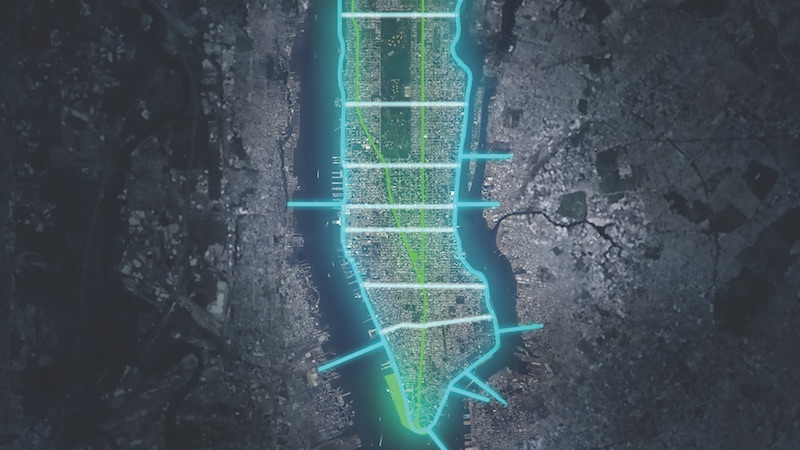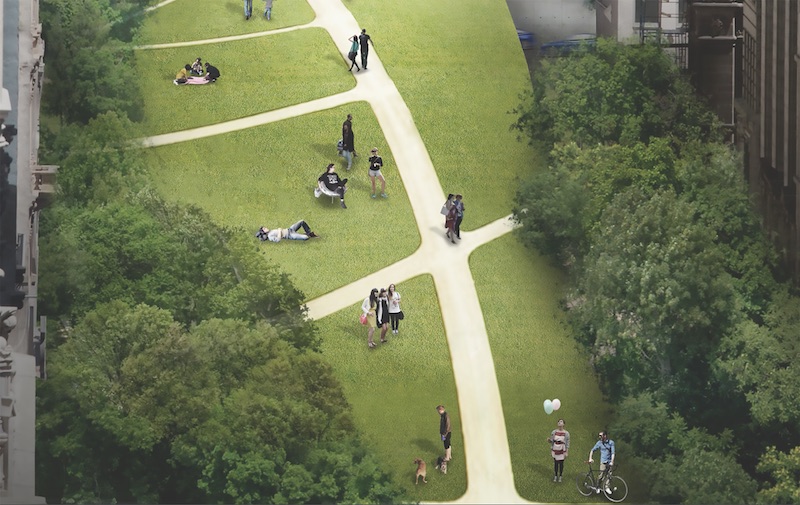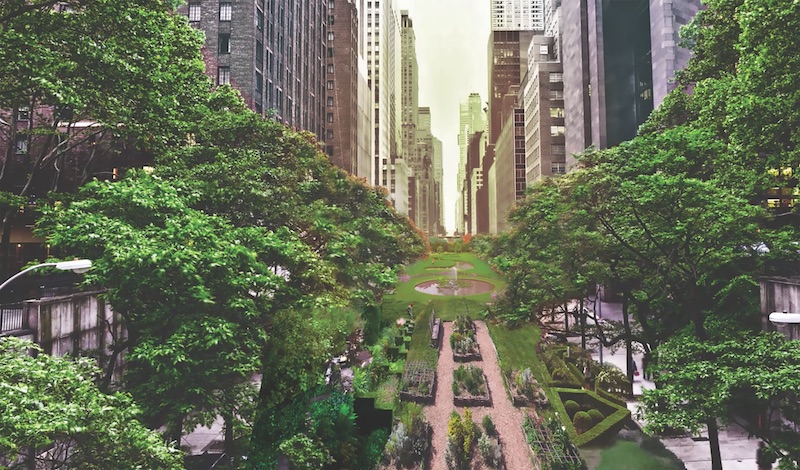What was once a busy thoroughfare filled with exhaust fumes and the sounds of honking horns becomes a quiet strip of land, its oil-stained concrete reclaimed by nature and the angry honks of traffic relegated to the past. This reclamation of New York’s streets may seem like a post-apocalyptic vision in a dystopian summer blockbuster, but it’s actually a radical new proposal from New York-based Edg, an architecture, engineering, and consulting firm, that would bring 24 miles of park space to New York City’s street grid.
Loop NYC leans heavily on driverless cars to create a new traffic flow around Manhattan. Existing cross streets and highways are converted into driverless expressways to optimize traffic flow in and out of the city.
The FDR and West Side highways will have one lane of traffic in each direction designated for autonomous vehicles. These highways will connect to major Manhattan streets, which themselves will be transformed into driverless car expressways. Featuring driverless vehicles exclusively would be 14th Street, 23rd Street, 34th Street, 42nd Street, 57th Street, 86th Street, and 110th Street. Pedestrian overpasses and underpasses will be installed around these streets to physically separate the vehicles and the pedestrians.
 Courtesy Edg.
Courtesy Edg.
The driverless cars can circulate using any combination of the new expressways and loops to expedite travel. Edg calculated the efficiency of Loop NYC to go from Grand Central Station to Lower Manhattan and back. This route would traditionally take about 40 minutes. With the Loop NYC plan in place it would only take 11 minutes.
 The proposal would designate some of New York’s busiest and widest streets to be used exclusively by driverless cars, significantly reducing travel times. Other streets, such as Broadway and Park Avenue, would eliminate cars completely and instead become pedestrian-friendly gardens, parks, and green space. Courtesy Edg.
The proposal would designate some of New York’s busiest and widest streets to be used exclusively by driverless cars, significantly reducing travel times. Other streets, such as Broadway and Park Avenue, would eliminate cars completely and instead become pedestrian-friendly gardens, parks, and green space. Courtesy Edg.
With the more efficient traffic flow, once congested streets could be reclaimed as park space with walking paths and bike lanes. A 13-mile-long pedestrian park would stretch from Battery Park in Lower Manhattan, run through Union Square, and then continue north on Broadway and Park Avenue. Broadway will become its own linear park filled with pathways and pedestrian bridges meant to mimic natural rolling hills.
The proposal builds on a current theme found in cities around the world to become greener, more pedestrian-friendly, and less reliant on cars. However, Loop NYC remains highly speculative for several reasons. Chief among them is the fact that a world of truly autonomous cars is still years away.
 Courtesy Edg.
Courtesy Edg.
Related Stories
AEC Tech | Feb 20, 2024
AI for construction: What kind of tool can artificial intelligence become for AEC teams?
Avoiding the hype and gathering good data are half the battle toward making artificial intelligence tools useful for performing design, operational, and jobsite tasks.
Sustainability | Nov 1, 2023
Researchers create building air leakage detection system using a camera in real time
Researchers at the U.S. Department of Energy’s Oak Ridge National Laboratory have developed a system that uses a camera to detect air leakage from buildings in real time.
75 Top Building Products | Aug 7, 2023
Enter today! BD+C's 75 Top Building Products for 2023
BD+C editors are now accepting submissions for the annual 75 Top Building Products awards. The winners will be featured in the November/December 2023 issue of Building Design+Construction.
Resiliency | Aug 7, 2023
Creative ways cities are seeking to beat urban heat gain
As temperatures in many areas hit record highs this summer, cities around the world are turning to creative solutions to cope with the heat. Here are several creative ways cities are seeking to beat urban heat gain.
AEC Innovators | Jun 15, 2023
Rogers-O'Brien Construction pilots wearables to reduce heat-related injuries on jobsites
Rogers-O'Brien Construction (RO) has launched a pilot program utilizing SafeGuard, a safety-as-a-service platform for real-time health and safety risk assessment. Non-invasive wearables connected to SafeGuard continuously monitor personnel to prevent heat exhaustion on jobsites, reducing the risk of related injuries. RO is the first general contractor to pilot this program.
Office Buildings | May 15, 2023
Sixteen-story office tower will use 40% less energy than an average NYC office building
This month marks the completion of a new 16-story office tower that is being promoted as New York City’s most sustainable office structure. That boast is backed by an innovative HVAC system that features geothermal wells, dedicated outdoor air system (DOAS) units, radiant heating and cooling, and a sophisticated control system to ensure that the elements work optimally together.
Design Innovation Report | Apr 27, 2023
BD+C's 2023 Design Innovation Report
Building Design+Construction’s Design Innovation Report presents projects, spaces, and initiatives—and the AEC professionals behind them—that push the boundaries of building design. This year, we feature four novel projects and one building science innovation.
Design Innovation Report | Apr 19, 2023
Reinforced concrete walls and fins stiffen and shade the National Bank of Kuwait skyscraper
When the National Bank of Kuwait first conceived its new headquarters more than a decade ago, it wanted to make a statement about passive design with a soaring tower that could withstand the extreme heat of Kuwait City, the country’s desert capital.
Design Innovation Report | Apr 19, 2023
HDR uses artificial intelligence tools to help design a vital health clinic in India
Architects from HDR worked pro bono with iKure, a technology-centric healthcare provider, to build a healthcare clinic in rural India.
3D Printing | Apr 11, 2023
University of Michigan’s DART Laboratory unveils Shell Wall—a concrete wall that’s lightweight and freeform 3D printed
The University of Michigan’s DART Laboratory has unveiled a new product called Shell Wall—which the organization describes as the first lightweight, freeform 3D printed and structurally reinforced concrete wall. The innovative product leverages DART Laboratory’s research and development on the use of 3D-printing technology to build structures that require less concrete.

















